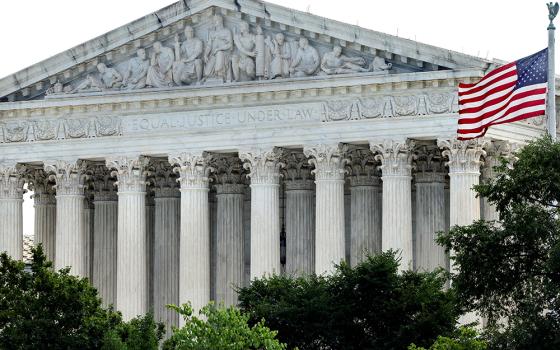
Fourth of July essay
Someday I should like to celebrate the Fourth of July by going to Mass at Santa Maria in Trastevere. This ancient basilica in the heart of one of Rome’s oldest neighborhoods was originally built in the fourth century during the reign of Pope Julius I on the spot of an even earlier Christian house founded by Pope Calixtus I in 224.
In the consistory of 1887, this venerable church was assigned to the newly created Cardinal James Gibbons, archbishop of Baltimore. Gibbons was only the second American to be raised to the purple and he took possession of his titular church on March 25, the feast of the Annunciation. As the date approached, Msgr. Denis O’Connell, rector of the Pontifical North American College in Rome, suggested that the occasion called for more than mere formalities.
Gibbons took the suggestion and delivered a powerful sermon defending the American constitutional model of church-state relations. “For myself, as a citizen of the United States, without closing my eyes to our defects as a nation, I proclaim, with a deep sense of pride and gratitude, and in this great capital of Christendom, that I belong to a country where the civil government holds over us the aegis of its protection without interfering in the legitimate exercise of our sublime mission as ministers of the Gospel of Jesus Christ,” the cardinal said. “But while we are acknowledged to have a free government, we do not perhaps receive due credit for possessing also a strong government. Yes, our nation is strong, and her strength lies, under Providence, in the majesty and supremacy of the law, in the loyalty of her citizens to that law, and in the affection of our people for their free institutions.”
In 1887 in Rome, those were fighting words. His biographer, Msgr. John Tracy Ellis, wrote, “Gibbons’ address, with its strong emphasis upon the liberty of the church in the United States, had an importance and significance quite beyond the ordinary sermon of this kind.”
In late 19th-century Rome, virtually all politics was seen through the lens of the pope’s loss of his temporal sovereignty over the Papal States. With the memory of Pius VI and Pius VII imprisoned by Napoleon, the spiritual independence of the papacy was thought to be bound up with its temporal independence. Both were threatened by the rise of liberal democratic regimes in Europe, most especially in Italy, which had annexed most of the Papal States in 1860 and took over Rome itself in 1870. Camillo Benso di Cavour, the leader of the Risorgimento, had suppressed almost all the monasteries and convents in Piedmont and seemed bent on doing the same throughout a united Italy. Liberalism, for all its protestations of guaranteeing freedom, was decidedly anticlerical in Europe.
Pope Pius IX’s 1864 encyclical Quanta Cura, which included the promulgation of the Syllabus of Errors, began as a reply to a speech by Charles de Montalembert calling for the reconciliation of the church with democracy. Montalembert titled his speech “A Free Church in a Free State.” None could question the religious devotion of this noble Frenchman, but the pope saw nothing but ruin coming from the French Revolution and its progeny. Pope Leo XIII declared in his 1885 encyclical Immortale Dei that the church was not committed to any particular form of government and that she could work with all, but he also went on to condemn freedom of religion and freedom of the press as threats to civil society and true religion.
This, then, was the context for Gibbons’ heroic address at Santa Maria in Trastevere. Despite the condemnations found in papal teaching, he held that the constitutional arrangements in America, specifically the freedom of religion guaranteed by the First Amendment, were a blessing to the Catholic church in the United States. In America, liberalism was not anti-clerical, as attested to by the many letters of congratulations Gibbons had received upon his elevation to the Sacred College from non-Catholics. The president of the United States, Grover Cleveland, had received Gibbons at the White House immediately before his departure for Rome.
As Gibbons descended the pulpit in Santa Maria he had set down a marker. “Here was the gauntlet of the benefit of American religious liberty thrown down by the new world to the old, which could not understand it until the Second Vatican Council,” writes Jesuit Fr. Gerald Fogarty.
Of course, Rome is far away and hot during the summer. So, perhaps for July 4, I will head out to the Job Corps Center outside Baltimore. A Job Corps Center? The building was formerly Woodstock College where Jesuit Fr. John Courtney Murray taught for most of his career. He was the theologian at Vatican II who, more than any other, helped the Old World understand the New on the subject of religious liberty. Murray had been silenced in the 1950s on orders from the Holy Office. Cardinal Alfredo Ottaviani upheld the traditional teaching that the Catholic faith should be established by law whenever Catholics were in the majority and that it should receive complete liberty when Catholics were in the minority. When confronted with the manifest double standard of this proposition, he thundered, “Error has no rights.”
Anti-Catholic zealots like Paul Blanshard had thrown Ottaviani’s position in the face of American Catholics: Did they truly support the First Amendment or were they bound by their religion to try to establish the Catholic church should they become the majority of the population? Murray argued that rights inhere in persons, not propositions, and that the religious liberty provisions of the First Amendment were “articles of peace” not “articles of truth.” The American bishops wanted to support him but they were wary of offending Vatican officials like Ottaviani.
The issue of religious liberty became the principal concern of the American bishops as John F. Kennedy’s campaign of 1960 witnessed an airing of anti-Catholic prejudices. The changed atmosphere in Rome after the election of Pope John XXIII gave Murray the confidence to bring forth his magnum opus, We Hold These Truths, defending what he termed “the American proposition.” As the U.S. bishops gathered for Vatican II, religious liberty became their chief doctrinal concern and Murray became one of the principal authors of the conciliar “Decree on Religious Liberty,” Dignitatis Humanae.
I have come to realize that Murray’s “American proposition” is more complicated than I had first thought and that Gibbons’ embrace of Americanism could become, in less critical hands, a reduction of Christian faith to a prop for Americanism. I love the First Amendment, don’t get me wrong. But I see that Catholic anthropology can never neatly coexist with what Sir Isaiah Berlin called “negative liberty,” which is how the Founding Fathers conceived of liberty, as a series of immunities, as “freedom from” coercion or government interference. I find that I disagree with Murray’s contention, “These constitutional clauses have no religious content. They answer none of the eternal human questions with regard to the nature of truth and freedom or the manner in which the spiritual order of man’s life is to be organized or not organized.” These clauses, in fact, prioritize freedom over truth, and a Christian theologian must be wary of admitting even a theoretical distinction between the two. I am especially distressed by Murray’s claim that “the dualism of mankind’s two hierarchically ordered forms of social life [the spiritual and temporal] has been Christianity’s cardinal contribution to the Western political tradition,” a claim that misconstrues the relationship of grace and nature in important ways.
So, perhaps this July 4, I will just head out to the backyard and cook a barbecue. My “pursuit of happiness” may take the form of some dry-rubbed ribs and margaritas. But I will think of Gibbons and Murray and be grateful for their attempt to do what I attempt to do, to be an American Catholic, loving my country and my church.
Michael Sean Winters is the author of Left at the Altar: How the Democrats Lost the Catholics and How the Catholics Can Save the Democrats.






